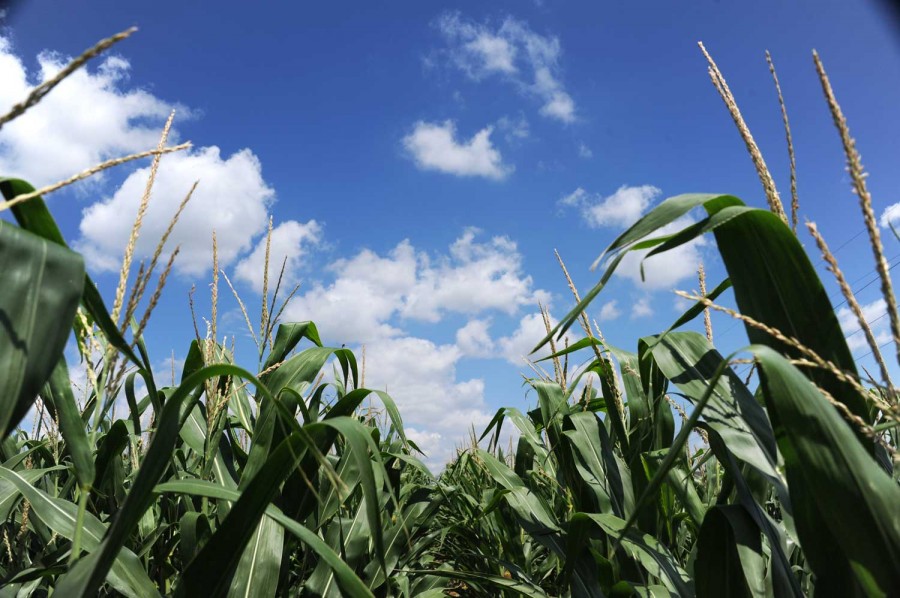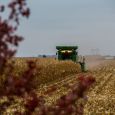The Gift of South Dakota
Subscriptions to South Dakota Magazine make great gifts!
Subscribe today — 1 year (6 issues) is just $29!
South Dakota’s Corn Culture
 |
Imagine South Dakota without corn. What would we feed our livestock? How would Mitchell decorate its Palace? Where would we hunt pheasants? What would farmers wear for caps?
Today we take for granted oceans of tasseled corn waving in the August breezes. We expect a local radio station to hold a "longest ear" or "tallest stalk" contest every September.
Corn, a leafy grass that gets little respect outside of agricultural circles, was ingrained into our prairie culture even before farm settlers arrived in the 19th century. Experts agree that the plant originated in Mexico or South America. As American Indians moved north, they brought along their seed corn.
When eastern farmers arrived in Dakota Territory, they assumed the growing season was too short for corn. The region was also considered borderline desert so annual rainfall was also a concern. At first it was planted as a sod crop.
"The summer the land was broken, there was little raised except sod corn and a few potatoes and vegetables," according to Herbert S. Schell in History of South Dakota. "Indeed at times it was possible to raise a fair sod crop of corn from seed dropped in holes and chopped in with an axe."
Corn farmers back then could only have dreamed of planting corn under today's conditions: with a multi-row planter, sitting in an air-conditioned cab listening to the radio or talking on a cell phone, while simultaneously applying weed-deterring solutions. Most were lucky to have a horse, an ox or a plow - or to know a neighbor who did.
Though that made farming hot, dusty, hard work, many weren't willing to trust amateurs at planting time because the family's livelihood often depended on the crop. "Corn planting was the trickiest operation performed during the spring season, and many farmers insisted on doing it themselves, without the aid of hired men or family members," according to Paula M. Nelson in The Prairie Winnows Out its Own.
Farmers stretched long rolls of wire from one end of the field to the other to establish rows and the proper distance between plants. "The wire contained knots every 40 inches, and when those knots passed through the planter mechanism, the machine dropped two or three seeds at the proper place in the row," according to Nelson. At the end of the row the farmer would move the wire and begin again.
Precision was critical. "If the farmer worked carefully, kept the horses neatly in line, and set the trap door in the planter boxes correctly, the corn would grow in forty-inch intervals in each direction and could be cultivated lengthwise and crosswise." Not many farmers today can boast such a feat.
Relying on the calendar told some farmers when it was time to plant corn and avoid frosts. Others planted when the leaves on hardwood trees were as large as a squirrel's or mouse's ear, or when they spotted the first bobolink or oriole, according to Funk & Wagnall’s Standard Dictionary of Folklore, Mythology and Legend. Some wouldn't trust kernels to the earth until spotting a redheaded woodpecker, though. Farmers could follow the advice of a corn-planting rhyme if they weren't sure how many kernels to plant:
One for the cut worm.
One for the crow
One for the blackbird
And three to grow.
Whether any of the old wives' tales or advice worked is debatable, but something was making South Dakota corn grow. Soon the state became regarded as one of nation's corn planting states.
"The skeptic on this question is no longer heard, and the man who would disdain South Dakota soil because of its inability to produce corn has been shown his error," Clifford Willis, an agronomist, wrote in Corn, a 1909 report. "In fact, men who once scoffed are now buying South Dakota farms on which they expect to grow corn."
In that year, 65.25 million bushels of corn were produced on 2,059,000 acres of South Dakota farmland. Willis said it averaged 31.7 bushels an acre but added, "We know that there are farmers who produced eighty and a hundred bushels to the acre. Someone must have produced a very low yield to so lower the average."
Conditions were better in 1914, and the State Department of Immigration used corn to tempt sellers to South Dakota. A promotional booklet, Corn Is King in South Dakota, boasted farmers' successes and the land's abilities in addition to mentioning popular attractions like the Black Hills.
"The area devoted to corn is increasing rapidly and is extending to every nook and corner of the state, and yields of 40 to 50 bushels per acre are the common thing," it read. Boast yields like that today and you'll not only be blamed for lowering the state's average but you might also find yourself laughed out of the local elevator's coffee circle.
Maybe those early promoters weren't so far off. Tourism officials are still using corn to attract visitors to one South Dakota city. Considering the number of visitors who pilgrimage to the city's corn-covered palace each year, it appears to be working.
Mitchell's corn-filled tradition began in 1892 when civic promoters decided to stage a harvest festival in a grain decorated building. Sioux City, Iowa, had been holding a similar event, first begun in 1887.
"However, when the fifth venture in 1891 was a financial failure, the backers decided to forego any future shows and it was then that the South Dakota town alertly seized the opportunity to capitalize on the Corn Palace theme," Robert F. Karolevitz wrote in Challenge: The South Dakota Story.
Obviously, Mitchell is proud of its Corn Palace image. Many businesses have adopted "palace" as part of their names and the school's athletic teams are known as the Kernels. And 500,000 people visit the palace, now at its third location, from Memorial Day to Labor Day each year.
Mitchell officials no longer question the power of corn. Neither did Delores Walter, a lifelong Howard farm wife, who wrote about rural living for the city's Daily Republic newspaper. A bumper crop almost halted her wedding.
"In 1948, the corn crop was so abundant that we didn't think we could take time off to get married. After all, a couple can get married any old time, but there will not always be a big corn crop to harvest," Walter wrote in a Nov. 5, 1992, column. "But being practical and being in love doesn't always go together. We were married November 6, 1948."
Corn has played an equally important role for Elk Point's Curry family members who have built their lives around corn. J.J. Curry began his Curry Seed Company with a 20-acre field in the 1930s. Today, over 3,000 acres are planted to seed corn within a 15-mile radius, and more and more farmers in the region are using their product.
J.J.’s son Ed, who led the family business when we spoke with him in 1997, said the development of hybrid seeds replaced the settlers' practice of open pollinated corn and created increased yields. "In the Thirties, an 80 bushel crop was tremendous," Curry said. "Now 180 bushels is obtainable, and certain test plots produce over 200 bushel yields."
Technology has produced hundreds of corn hybrids, all varying in maturities to suit different needs. Curry research and testing has produced 20 varieties for the current market.
Advanced technology also allows seed corn to be harvested in half the time and to be dried mechanically with natural gas heat. Such improvements always come with a price, in this case it's increased production costs.
That's not enough to make Curry long for the days of hand picking, when harvesting 100 bushels in a day was a mark of achievement.
Though he doesn't miss "the good old days," he has tried to use the stories to cheer up young detasselers. Once on a hot day in wet conditions when the kids were really tired, he told them he had been detasseling corn since 1938.
It didn't stir much encouragement. One little shaver looked at him and said, "You sure as heck haven't gotten very far."
Burton Ode, a farmer from Brandon, also remembered when corn was picked by hand. To help with the harvest, farmers hired transients who worked their way north following the grain harvest and then worked back south picking corn.
For their efforts, Ode recalled men earning first two cents and then 10 cents a bushel. Though horse-drawn corn pickers had arrived the 1920s and '30s, they weren't much better. "They were meager machines," he told us in 1997. "It took a lot of horses to pull them."
Then single and two-row pickers came in the late 1930s. "They were real good machines but no one could afford them."
Finally, after World War II things boomed and mechanical pickers ruled until the late 1950s or early ‘60s. That's when Ode said an Illinois farmer decided there must be a way to use a combine for something other than grains. "He rigged up something in the front of the combine to make the corn run into it," Ode said. "They really took off."
Machines today are even more laborsaving. Gone are the days when farmers scraped the kernels from each cob. They no longer have to shell it by flailing it, driving oxen or horses across it, or by driving the ear through a metal ring with a mallet. Picking, husking and shelling can be done in one easy step now.
Eighty-five years after the Department of Immigration published its booklet, corn is still king in South Dakota. In 2010 farmers harvest 569.7 million bushels of corn, the state’s third largest crop on record.
How much corn is too much? That's the million-dollar question every year in South Dakota. The largest percentage of the corn raised in South Dakota is used as livestock feed.
It's hard to believe a little kernel of corn can do so much to critters but each kernel contains 61 percent starch, 19.2 percent protein and fiber, 3.8 percent oil and 16 percent water. Corn that isn't used for animal feed is either exported or used to make co-products, all of the different products corn can be used in. That's the fastest growing part of the industry.
One bushel of corn can yield 31.5 pounds of starch, 33 pounds of sweetener or 2.5 gallons of ethanol. You can also get 10.9 pounds of protein feed, 2.6 pounds of gluten meal or 1.6 pounds of corn oil.
Supermarket shelves hold more than 3,500 products that contain corn in some form - everything from detergents to crayons to batteries, sweeteners, soda pop, golf tees, road de-icer, trash bags and fuel in the form of ethanol, which is a multi-million dollar industry all of its own.
Corn can be grown almost anywhere, but because East River counties enjoy adequate rainfall, good soils and the necessary heat units, they tend to produce the most corn. Top producers in 2010 were Minnehaha, Spink, Brown, Moody, Lincoln, Hutchinson, Brookings, Union, Turner and Beadle counties, each topping 18 million bushels. Other counties such as Roberts, Kingsbury, Lake, McCook and Charles Mix, which produced around 17 million bushels, weren't far behind.
Statistics show Harding, Perkins, Lawrence, Meade, Custer, Fall River and Jackson counties produced little or no corn that same year. Land west of the river tends to be better suited for rangeland, winter wheat or other small grains and sunflowers.
Early farmers didn't have the benefit of that knowledge. "The earliest pioneers with any agricultural experience in their past were doomed by their ignorance of the new land since they were determined to practice the eastern forms of farming on the stubborn sod of Hand County," Scott Heidepriem wrote in Bring on the Pioneers! History of Hand County.
They modified the methods after several failures after discovering eastern corn needed a longer growing season to avoid being nipped by September frost. Eventually, Hand County fanners and others turned to a shorter variety such as squaw corn.
The further west pioneers tried to grow corn the more difficult it became. "For farmers the west river country posed a riddle they had not yet been able to answer. Settlers had lived on the land for fifteen years or so by the 1920s, but farmers still learned mostly by trial and error what their land could produce," according to Paula M. Nelson.
They kept trying even though they grew it profitably only every other year.
"Given the difficult environment, the commitment to corn is surprising, but corn was a versatile crop with many uses, and it also symbolized 'the farm' to west river residents ...."
It's nice to know some things will never change. An unending sea of green leaves and golden tassels swaying in the breeze will always symbolize the farm to South Dakotans.
Editor’s Note: This story is revised from the July/August 1997 issue of South Dakota Magazine. To order a copy or to subscribe, call 800-456-5117.










Comments